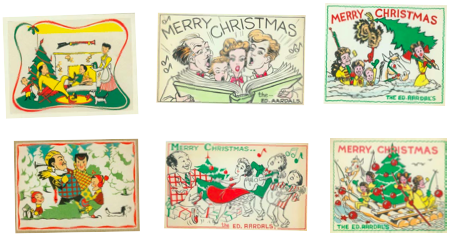For many of us, this is the one time of year when we don’t mind the daily visit to the mailbox. Amidst the junk mail and bills that still find their way to our homes are true postal gems: holiday greeting cards. Whether from a friend living cross country from whom we haven’t heard since last December or a family member we talk to regularly, holiday cards are reminders that we’re remembered—and valued enough to deserve the time and effort that cards demand during a hectic season. They provide a visual oasis of sorts, causing us pause during our days filled with shopping, cleaning and decorating to be mindful of what’s really important: connection with those who are special in our lives.
 The tradition of sending personal greeting cards in celebration of the holiday season began in the United States in the mid-1870s. It was then that Louis Prang, a printer, lithographer and publisher, produced the first commercial Christmas cards, and because of this he is sometimes known as the “Father of the American Christmas Card.” Today, more than a billion cards, decorated with illustrations or photos of friends and family, are delivered throughout the country during the holiday season.
The tradition of sending personal greeting cards in celebration of the holiday season began in the United States in the mid-1870s. It was then that Louis Prang, a printer, lithographer and publisher, produced the first commercial Christmas cards, and because of this he is sometimes known as the “Father of the American Christmas Card.” Today, more than a billion cards, decorated with illustrations or photos of friends and family, are delivered throughout the country during the holiday season.
For the staff working at the Disney Studio from the late ‘30s to the ‘70s, the holidays presented a special opportunity to send greetings in a way that showcased their unique talents. During their time away from work, these artists and animators used the skills typically reserved for the production of award-winning films to fashion entertaining cards for their extended families, friends, and coworkers. In the Museum’s Theater Lobby, an area visitors often overlook due to its location off the regular gallery path, the Collections department has displayed more than 50 of these special hand-drawn cards, which were the focus of December’s Look Closer presentations.
The majority of the cards were originally the property of legendary Disney Studio comic strip artist Al Taliaferro (1905-1969), who received them from his coworkers during the holidays, and saved them over the following years. The collection was eventually purchased at auction and donated to the Walt Disney Family Foundation. In addition to these, the Museum was able to acquire on loan, from the nieces of concept designer Mary Blair, four cards designed by female artists at the Studio. Two of the cards were done by Blair, whose art and artistry is a feature in the Museum Lower Lobby, while the other two are creations of Retta Scott Worcester, the first Disney female animator.
The varying content and unique styles of the cards give the viewer a glimpse of the Disney staff’s amazing talents and personalities, and in some cases, a memorable occurrence in their lives. For example, the card designed by longtime animator and director, Ham Luske (1903-1968), shows a Santa-driven helicopter hovering over a hill, on which are situated homes with only chimneys on the foundations. The curious illustration refers to the 1961 Bel Air fires, which broke out in the area where the Luskes lived, and which consumed all the houses on the hill—except theirs. The phrases, “Chiminy Christmas!” and “the Lucky Luskes,” along with a hand pointing to the one intact house on the hill, drive home the point.
Legendary artist, author, and story man Bill Peet (1915-2002) is another whose cards are featured in the display. Two of five show playful sketches of family members making creative plays on the work “Noel.” Others contain fun scenes that belie Peet’s exceptional gift for storytelling (and forecast his second career as an author of more than 30 children’s books).
Renowned animator (and one of Disney's Nine Old Men) John Lounsbery (1911-1976) discreetly worked in political commentary on the front of one of his cards, which was likely created sometime during the early ‘60s. The illustration shows a dog and cat looking over a long list of “...the nicest people in the world...,” but if the viewer looks closely, he can see the name “Castro” written in among the others but crossed out with a red line.
What is especially noteworthy about the collection is that the cards are all hand-produced, without the aid of computers or software, and yet they are striking in design, color, story and layout. They are wonderful, personal reminders of how talented people can use their extraordinary gifts to deliver special holiday greetings to those most important in their lives.
Mary Beth Culler
Museum Interpreter
Image above: Cards by Animator Edwin Aardal, courtesy The Walt Disney Family Museum.
